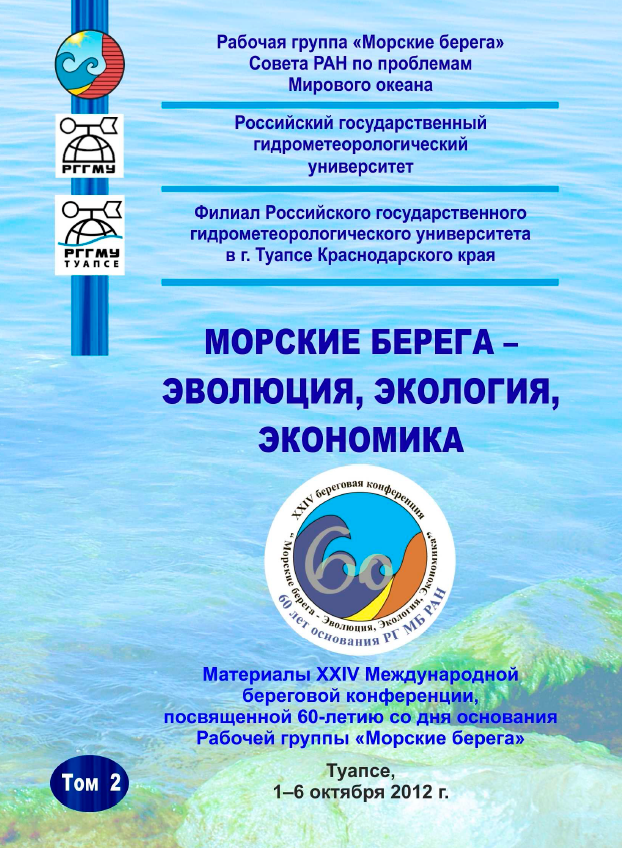Russian Federation
Russian Federation
Russian Federation
BISAC NAT010000 Ecology
BISAC NAT045050 Ecosystems & Habitats / Coastal Regions & Shorelines
BISAC NAT025000 Ecosystems & Habitats / Oceans & Seas
BISAC NAT045030 Ecosystems & Habitats / Polar Regions
BISAC SCI081000 Earth Sciences / Hydrology
BISAC SCI092000 Global Warming & Climate Change
BISAC SCI020000 Life Sciences / Ecology
BISAC SCI039000 Life Sciences / Marine Biology
BISAC SOC053000 Regional Studies
BISAC TEC060000 Marine & Naval
The possibilities of using terrestrial laser scanning technology (TLS) in natural science researches are considered. The results of laser scanning modeling area of the coastal zone of the Curonian spit are presented. Marked by the perspectives of using TLS for monitoring morpholithodynamic processes on the coast.
Baltic Sea
Технологии НЛС происходят из геодезии и этим обусловлены области их применения уже ставшие классическими: топосъемка, сканирование сложных инженерных сооружений и т.д. Однако, изображения, получаемые в процессе НЛС, обычно несут чрезвычайно большой объем информации, являющийся в ряде случаев избыточным.
1. Abellán A., Jaboyedoff M., Oppikofer T., Vilaplana J.M. Detection of millimetric deformation using a terrestrial laser scanner: experiment and application to a rockfall event // Natural Hazards and Earth System Science. 2009. Vol. 9, Issue 2. Pp. 365-372.
2. Abellán A., Vilaplana J., Martínez J. Application of a long-range terrestrial laser scanner to a detailed rockfall study at Vall de Núria (Eastern Pyrenees, Spain) // Engineering Geology. 2006. Vol. 88, Issues 3-4. Pp. 136-148.
3. Avian M., Bauer A. First results on monitoring glacier dynamics with the aid of terrestrial laser scanning on Pasterze Glacier (Hohe Tauern, Austria) // Grazer Schriften der Geographie und Raumforschung. 2006. Vol. 41. Pp. 27-35.
4. Bienert A., Maas H.-G., Scheller, S. Analysis of the information content of terrestrial laserscanner point clouds for the automatic determination of forest inventory parameters // Workshop on 3D Remote Sensing in Forestry, 14th - 15th Feb 2006, Vienna.
5. Forman P., Parry I. Rapid data collection at major incident scenes using three dimensional laser scanning techniques // Proceedings of 35th International Carnahan Conference on Security Technology, October 16-19, 2001, London, England. Pp. 60-67.
6. Hiatt M.E. Sensor integration aids mapping at Ground Zero // Photogrammetric Engineering and Remote Sensing. 2002. Vol. 68, Issue 9. Pp. 877-879.
7. Hobbs P.R.N., Humphreys B., Rees J.G., Tragheim D.G., Jones L.D., Gibson A., Rowlands K., Hunter G., Airey R. Monitoring the role of landslides in ‘soft cliff’ coastal recession // Instability - Planning and Management / McInnes R.G., Jakeways, J. (eds.). Thomas Telford, London, 2002. Pp. 589-600.
8. Hodge R., Brasington J., Richards K. Analysing laser-scanned digital terrain models of gravel bed surfaces: linking morphology to sediment transport processes and hydraulics // Sedimentology. 2009. Vol. 56, Issue 7. Pp. 2024-2043.
9. Hodge R., Brasington J., Richards K. In situ characterization of grainscale fluvial morphology using terrestrial laser scanning // Earth Surface Processes and Landforms. 2009. Vol. 34, Issue 7. Pp. 954-968.
10. Hunter G., Pinkerton H., Airey R., Calvari S. The application of a long-range laser scanner for monitoring volcanic activity on Mount Etna // Journal of Volcanology and Geothermal Research. 2003. Vol. 123, Issues 1-2. Pp. 203-210.
11. Pfeifer N., Lindenbergh R., Rijntjes C. Dune monitoring with terrestrial laser scanning at Egmond beach. Technical report, 2005.
12. Poulton C.V.L., Lee J., Hobbs P., Jones L., Hall M. Preliminary investigation into monitoring coastal erosion using terrestrial laser scanning: case study at Happisburgh, Norfolk // Bulletin of the Geological Society of Norfolk. 2006. № 56. Pp. 45-64.
13. Prokop A. Assessing the applicability of terrestrial laser scanning for spatial snow depth measurements // Cold Regions Science and Technology. 2008. Vol. 54, Issue 3. Pp. 155-163.





